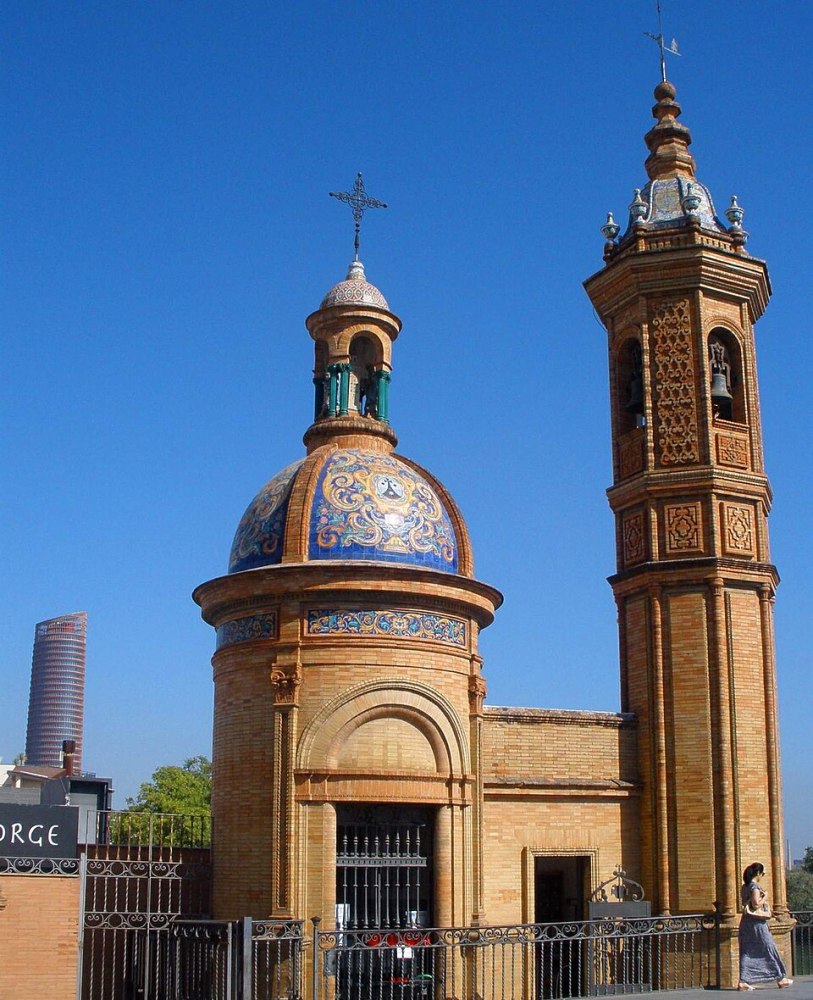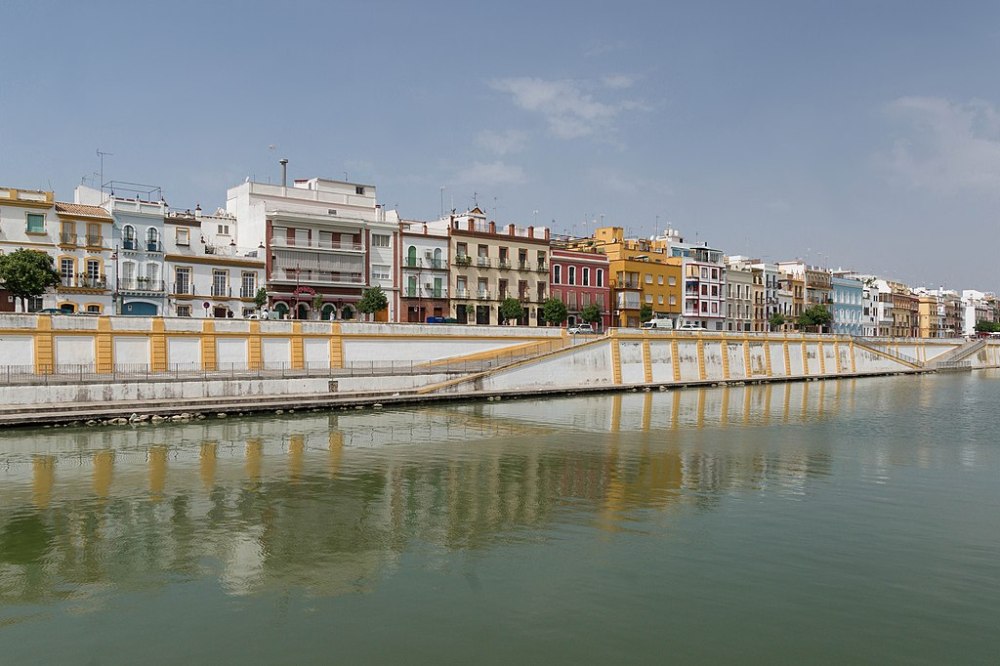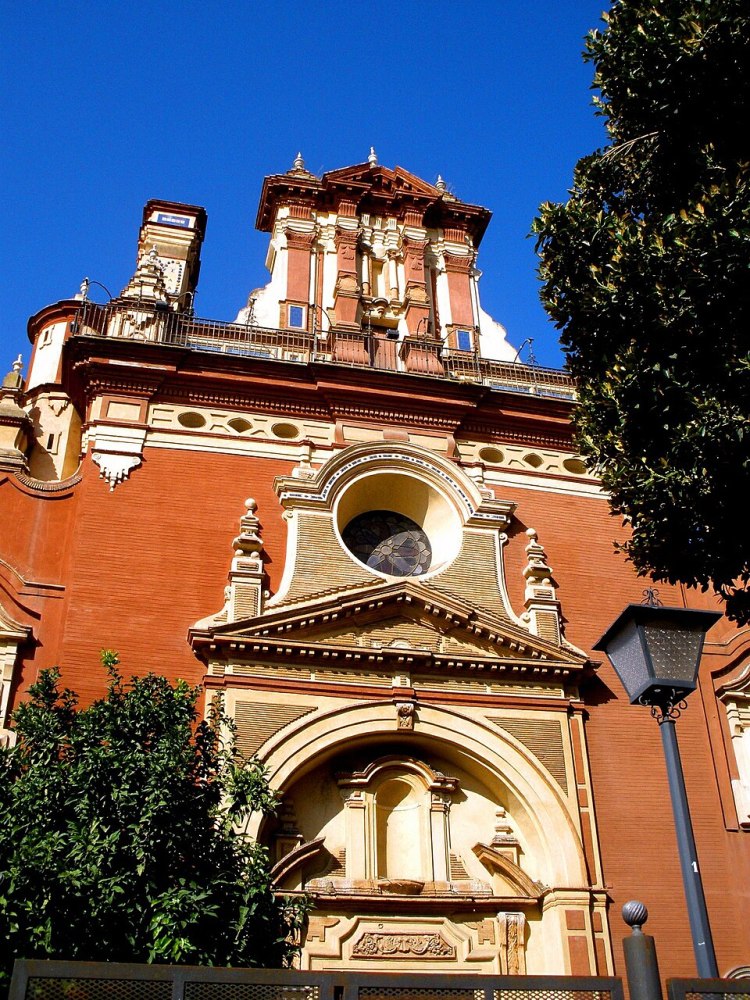What to See in Triana, Seville: Discover Andalusia’s Most Soulful Neighborhood

What to See in Triana, Seville: Discover Andalusia’s Most Soulful Neighborhood
Do you believe Seville has a “special color”? It does. And a large part of that pigment was created in the Triana neighborhood. Welcome to the other side of the river, to the “independent republic” of Seville. If the historic center impresses you with its monuments, Triana will capture your heart with its magic. This isn’t just a neighborhood; it’s a way of life. The cradle of sailors, potters, and artists, Triana is the vibrant, gypsy soul that acts as a counterpoint to the majesty of the Andalusian capital.
The Touring Pandas invites you to cross the Isabel II Bridge and enter a place where history is told on the tiled walls and flamenco isn’t a show, it’s the very air you breathe. Are you ready for a walk into the heart of the most authentic Triana?
History and Tradition: The Soul of the “Independent Republic” 🧭
To understand what to see in Triana, you first have to understand what Triana is. For centuries, this district lived separately from Seville, connected only by an unstable “Bridge of Boats.” This physical separation forged a unique, proud character and a deep sense of belonging. It’s said that Triana residents aren’t from Seville; they are from Triana.

The legend of its name is as dual as the neighborhood itself. Some say it comes from its Roman founder, the emperor Trajan himself (Trajana-Triana). Others, more poetic, suggest it comes from “Tres-Ana,” the union of three goddesses (one Celtic, one Roman, and the Christian Saint Anne) or, more likely, from the three arms that the river once formed here.
But the true identity of Triana is built on three historic pillars:
-
Earth and Clay (The Potters) 🏺
Triana is made from the mud of the Guadalquivir River. Its clay soil made it the city’s pottery center since Roman and, especially, Arab times. The clay artisans, or ‘loceros,’ shaped the visual identity of not just the neighborhood, but all of Seville. Those vibrant tiles decorating the Plaza de España or the Palace of Peter I in the Alcázar? Many of them came from the kilns of Triana.
To walk down Calle Alfarería or Calle Antillano Campos is to walk through the living history of this art form, which today is preserved like treasure at the Centro Cerámica Triana.
-
The River and the Sea (The Sailors)
Triana always lived facing the river but dreaming of the sea. As Seville’s port was the “Gateway to the Indies,” Triana was home to the sailors, navigators, and explorers who set sail for the New World.
It was here that legendary crews were formed, like that of Ferdinand Magellan, who, before departing in 1519 for the first circumnavigation of the globe, prayed before the Virgin of Victory in the Church of Santa Ana. This maritime tradition lives on in the devotion to the Esperanza de Triana (Hope of Triana), whose anchor on her mantle symbolizes that eternal bond with the river and navigation.
-
The People and the “Duende” (The Gypsies and Flamenco) 💃
An Andalusian saying: it’s said that “duende” means having charm, magic. An expression closely tied to flamenco and the culture.
The third pillar is, perhaps, the most intangible and the most famous: flamenco. When the Catholic Monarchs expelled the gypsy people from the city center, many settled here in Triana. In the communal courtyards, known as corrales de vecinos (like the Corral de la Cerca Hermosa or the Corral de las Flores), a unique culture of coexistence was forged.
In those courtyards, as evening fell, the cante (singing), toque (guitar playing), and baile (dancing) ceased to be a lament and became an art form. Triana might not be where flamenco was born, but it was where it was perfected, where it grew up, and where it gave the world some of its most legendary figures. It is, without a doubt, the cradle of flamenco song in Seville.
Triana’s Must-Sees: A Walk Through Its Essential Corners
Now that you know its soul, let’s explore its body. Triana is discovered on foot, without rushing, letting yourself be guided by instinct. We suggest a logical route so you don’t miss a thing.
The Isabel II Bridge (The “Triana Bridge”)
It’s the border and the symbol. This iron bridge, built between 1845 and 1852, is a jewel of 19th-century engineering.
Don’t miss: Crossing it at sunset. It’s the mandatory photo op. On one side, monumental Seville (the Giralda, the Torre del Oro, the Maestranza bullring); on the other, the colorful welcome of Calle Betis. Look for the small chapel that guards the entrance to Triana: the Capillita del Carmen, affectionately known as ‘El Mechero‘ (The Lighter) because of its shape.

The Triana Market 🍲
The belly of the neighborhood. Located on the remains of the aforementioned Castle of San Jorge, this food market is an explosion of life. In the morning, it’s a traditional market with stalls of fruit, fresh fish, and ham.
Don’t miss: Its bars. It’s one of the best places in Seville for a morning tapeo (tapas crawl). Try the pescaíto frito (fried fish) or an ice-cold beer while you watch the hustle and bustle. And, of course, go downstairs to visit the Museum of the Castle of San Jorge. It’s a striking contrast to go from the bustling life of the market to the silence of the Inquisition’s ruins.
Calle Betis: The Triana Postcard 🌅
Possibly the most photographed street. This line of narrow, vibrantly colored facades looking directly over the Guadalquivir River is the iconic image of Triana.

Don’t miss: A walk at dusk. The views of the Torre del Oro and the Giralda, tinted by the setting sun, are simply magical. Although it’s a very touristy area, sitting on one of its terraces for a drink as night falls is an experience you have to have.
The Clay Legacy: Centro Cerámica Triana
If you want to understand the neighborhood’s pottery pillar, this is your stop. Housed in the old and emblematic Santa Ana ceramic factory, this modern interpretive center shows you the complete manufacturing process, the old kilns, and historic pieces. It’s an enjoyable and essential visit to grasp the essence of Triana.
The Axis of Faith: Calle Pureza and its Temples ✝️
This street is the spiritual artery of Triana. It’s quieter, more residential, and home to the two jewels of Triana’s devotion:

- Real Parroquia de Santa Ana: Known as the “Cathedral of Triana.” It is the oldest church in Seville, founded in 1266 by order of King Alfonso X “The Wise” (who, according to legend, had it built in gratitude for being cured of an eye ailment). It is an imposing Gothic-Mudéjar church.
- Capilla de los Marineros (Sailors’ Chapel): A few steps further, you’ll find the home of Seville’s most fervent devotion: the Esperanza de Triana. Go inside (entry is usually free) to see the “Queen of Triana,” an image that causes an absolute frenzy of popular fervor during the Madrugá (the dawn of Good Friday) of Holy Week.
Neighborhood Life: Calle San Jacinto
The old road to the Aljarafe region is now the main commercial street. Largely pedestrianized, it’s perfect for taking the pulse of daily life, with its shops, classic tapas bars (like Blanca Paloma), and the beautiful Baroque Church of San Jacinto.

Triana and Flamenco: Where the “Magic” Speaks
This deserves its own chapter. As we said, Triana is the cradle of Sevillian flamenco. This art form is not seen here as a product for tourists, but as a part of life.
Although the golden age of the corrales de vecinos is over, the spirit remains. Triana is the ideal place to escape the artificial shows and seek authenticity. The neighborhood is dotted with tablaos (venues dedicated to live flamenco) and peñas flamencas (cultural associations) where respect for the art is paramount.
Here, the audience’s silence is as important as the ‘quejío’ (wail) of the singer. To see a flamenco show in Triana, especially at night, is to feel a shiver down your spine, to understand that word that resonates so much: tener duende (to have duende). It is an intimate, powerful experience that connects directly with the neighborhood’s gypsy and artistic soul.
The Best Option: Experience Triana and Flamenco with Us
Reading about Triana’s magic is one thing, but what if we told you that you could feel it in person?
Triana is pure magic, but it can be overwhelming to know where to find that authenticity. That’s why we designed our Triana Tour & Flamenco Show.
We want you to feel like a friend we’re taking to our favorite spots. We start at the majestic Torre del Oro, and from there, our expert guide (in small groups of no more than 12 people) will take you on a sunset stroll along the riverbank. We’ll cross the bridge, delve into Triana’s mystical side streets, tell you the stories that aren’t in the guidebooks, and cap off the night with the perfect finishing touch: a 60-minute live flamenco show in one of the most respected and authentic tablaos in the neighborhood, the Teatro Flamenco Triana.
It’s not just a tour; it’s a 2.5-hour immersion into the soul of Triana. Are you in?
Complete Your Day in Seville
Triana is the perfect finishing touch for a day of discovering Seville. If our evening walk whets your appetite for more, here are other essential experiences to make your visit to the city complete.
You can see all our Seville adventures at this link.
- Seville Alcázar Guided Tour: Game of Thrones fan? Even if you’re not, the Real Alcázar will leave you breathless. It is the oldest royal palace still in use in Europe and a masterpiece of Mudéjar art. With our tour, you’ll skip the lines, and an expert guide will reveal the secrets of its dreamlike courtyards and gardens.
- Seville Real Alcázar & Cathedral Guided Tour: The definitive monumental ‘pack.’ In 3 hours, we not only explore the Alcázar, but we also conquer the Cathedral (the largest Gothic cathedral in the world) and climb its symbol: the Giralda. Plus, we’ll tell you the story of Christopher Columbus’s tomb.
- Seville Highlights: Full Day Tour: Want it all? You’ve got it. This is the total experience. A full day with our guides to see everything without rushing and without lines: the Alcázar, the Cathedral, the Giralda… and yes, it also includes the guided walk through Triana and the flamenco show at sunset!
Ready to Cross the Bridge?
To get to know Triana, it’s best to put the map away and use your senses. It’s a place to feel: enjoy the atmosphere of its tapas bars, the scent of orange blossoms in its streets, and the live music drifting from its courtyards.
Seville will impress you, but Triana grabs your heart and, as the songs say, never lets go. We’ve given you the keys; now it’s your turn to experience it.
Are you ready to feel the magic? We’ll be waiting for you in Seville!
